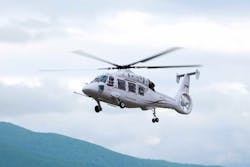Certification Trials of Helicopter K-62 to Be Commenced in 2018
Russian Helicopters Holding (part of Rostec State Corporation) intends to commence certification trials of the bleeding-edge helicopter Ka-62 early in 2018. The trials are to be completed within two years, following which the machine will be available for commercial use.
Progress Aresenyev Aviation Company has by now produced two flight models. The first one has already undergone in-plant tests in May 2017. According to the testing programme, Ka-62 has already performed the first circuit-circling at 110 km/h for 15 minutes. The test pilots of JSC Kamov, the principle principal of Ka-62, have tested its overall operating performance, main energy supply systems, airborne equipment and power unit.
The second flight model has been unveiled to the Russian and foreign audiences at the third Eastern Economic Forum.
"We continue preparing Ka-62 helicopter for mass production. We will conduct a series of ground and flight certification trials, following which we will offer the model to the market. This will be a state-of-the-art hi-tech helicopter, which I believe is bound to enjoy a good demand on the market," said Andrei Boginsky, the CEO of Russian Helicopters.
Moreover, a third flight model of helicopter Ka-62 is scheduled for the development in 2018.
Helicopter Ka-62 is designed for the passenger carriage, off-shore works, emergency medical aid, search and rescue, conveyance of cargo inside the cabin and as suspended load, patrolling and environmental monitoring. The high operating ceiling and high power loading of its engines enable Ka-62 to perform search-and-rescue and evacuation works in mountainous areas.
Ka-62 was made of the most advanced polymeric composite materials (PCM). The amount of PCM in the helicopter was brought to 60% in weight, which allowed reducing the weight of the empty machine, consequently increasing its speed, manoeuvrability and lifting capacity, as well as reduce fuel consumption. The helicopter stands out with perfect aerodynamic lines of the airframe, high capacity of the cargo and passenger cabin, and the tricycle landing gear with tail support.
Russian Helicopters — part of Rostec State Corporation — is one of the global leaders in the helicopter industry, and the only helicopter design and production powerhouse in Russia. Russian Helicopters was founded in 2007, and is headquartered in Moscow. The company comprises five helicopter production plants, two design bureaus, a spare parts production and repair facilities, as well as an aftersale service branch responsible for maintenance and repair in Russia and abroad. Amongst Russian Helicopters customers are Russian ministries and state authorities (Ministry of Defense, Ministry of Internal Affairs, Emergency Control Ministry), air companies (Gazpromavia, UTair), and large Russian and foreign enterprises. In 2016, IFRS revenues of Russian Helicopters were RUB 214.3 billion, and the deliveries reached 189 helicopters.
Rostec State Corporation is a Russian corporation founded in 2007 for promoting the development, production and export of hi-tech civilian and military industrial products It comprises 700 organizations, which have by now formed 11 holding companies in the military-industrial complex, and three in the civil industry, with over 80 organizations being under direct control. Rostec’s portfolio comprises renowned brands, such as Avtovaz, Kamaz, Kalashnikov Concern, Russian Helicopters, and VSMPO-AVISMA. Rostec organizations are located in 60 constituent entities of Russia, and supply products to over 70 countries. The 2016 consolidated revenues of Rostec were RUB 1.266 trillion, while its consolidated net income and EBITDA amounted to RUB 88 and 268 billion. The 2016 average salary within the Corporation was RUB 44 thousand. The new Rostec strategy sees it as the utmost priority to provide Russia with technological advantages at highly competitive international markets. Some of Rostec’s primary goals are the introduction of a new technological paradigm and digitalization of the Russian economy.
